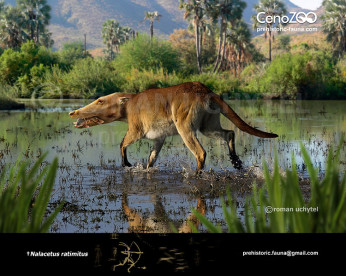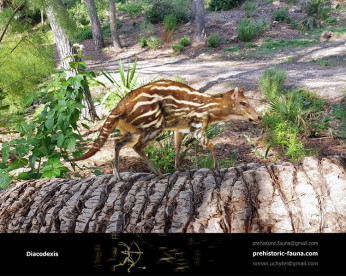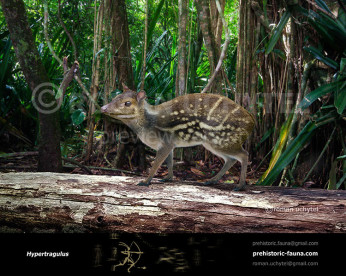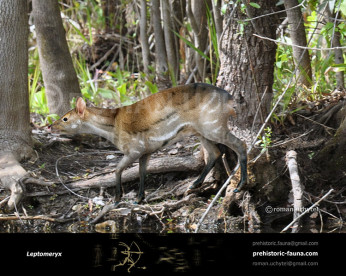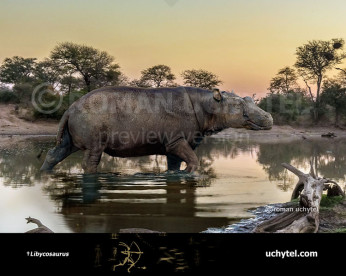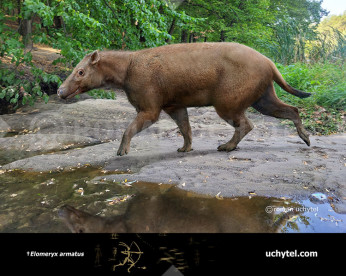Indohius
212212Indohyus (Indohyus Ranga Rao, 1971)
Order: Artiodactyla
Family: Raoellidae
Genus: Indohyus
Time period: lived in Asia during the Eocene (Asia, Pakistan)
Size: Weight estimated at up to 10 kg.
Indohyus ("India's pig") is a genus of extinct artiodactyl known from Eocene fossils in Asia. This small deer-like animal found in the Himalayas is a close relative of whales.
The fossils were discovered among rocks that had been collected more than 30 years ago in Kashmir by the Indian geologist A Ranga Rao who found a few teeth and parts of a jawbone, but when he died many rocks had yet to be broken open. Ranga Rao's widow gave the rocks to Professor Thewissen, who was working on them when his technician accidentally broke one of the skulls they had found and Thewissen recognised the ear structure of the auditory bulla, formed from the ectotympanic bone in a shape which is highly distinctive, found only in the skulls of cetaceans both living and extinct, including Pakicetus.
About the size of a raccoon or domestic cat, this herbivorous deer-like creature shared some of the traits of whales, and showed signs of adaptations to aquatic life, including a thick and heavy outer coating to bones which is similar to the bones of modern creatures such the hippopotamus, and reduces buoyancy so that they can stay underwater. This suggests a similar survival strategy to the African mousedeer or water chevrotain which, when threatened by a bird of prey, dives into water and hides beneath the surface for up to four minutes.
A December 2007 article in Nature by Thewissen et al. used an exceptionally complete skeleton of Indohyus from Kashmir to indicate that raoellids may be the "missing link" sister group to whales (Cetacea). All other Artiodactyla are "cousins" of these two groups. The authors suggest this documents an intermediate step in the transition back to water completed by the whales, and suggests a new understanding of the evolution of cetaceans.
However, not all paleontologists are firmly persuaded that Indohyus is the transitional fossil that cetacean-origin experts were looking for. O'Leary & Gatesy 2008 postulates an extinct group of carnivorous mammals called "mesonychids" as more closely related to cetaceans. Additionally, ScienceNOW, a daily news feature of the journal Science, notes that "cetaceans are so different from any other creature that researchers haven’t been able to agree which fossil relatives best represent their nearest ancestors."
Two species have been described.
From Wikipedia, the free encyclopedia
Indohyus (Indohyus Ranga Rao, 1971)
Order: Artiodactyla
Family: Raoellidae
Genus: Indohyus
Time period: lived in Asia during the Eocene (Asia, Pakistan)
Size: Weight estimated at up to 10 kg.
Indohyus ("India's pig") is a genus of extinct artiodactyl known from Eocene fossils in Asia. This small deer-like animal found in the Himalayas is a close relative of whales.
The fossils were discovered among rocks that had been collected more than 30 years ago in Kashmir by the Indian geologist A Ranga Rao who found a few teeth and parts of a jawbone, but when he died many rocks had yet to be broken open. Ranga Rao's widow gave the rocks to Professor Thewissen, who was working on them when his technician accidentally broke one of the skulls they had found and Thewissen recognised the ear structure of the auditory bulla, formed from the ectotympanic bone in a shape which is highly distinctive, found only in the skulls of cetaceans both living and extinct, including Pakicetus.
About the size of a raccoon or domestic cat, this herbivorous deer-like creature shared some of the traits of whales, and showed signs of adaptations to aquatic life, including a thick and heavy outer coating to bones which is similar to the bones of modern creatures such the hippopotamus, and reduces buoyancy so that they can stay underwater. This suggests a similar survival strategy to the African mousedeer or water chevrotain which, when threatened by a bird of prey, dives into water and hides beneath the surface for up to four minutes.
A December 2007 article in Nature by Thewissen et al. used an exceptionally complete skeleton of Indohyus from Kashmir to indicate that raoellids may be the "missing link" sister group to whales (Cetacea). All other Artiodactyla are "cousins" of these two groups. The authors suggest this documents an intermediate step in the transition back to water completed by the whales, and suggests a new understanding of the evolution of cetaceans.
However, not all paleontologists are firmly persuaded that Indohyus is the transitional fossil that cetacean-origin experts were looking for. O'Leary & Gatesy 2008 postulates an extinct group of carnivorous mammals called "mesonychids" as more closely related to cetaceans. Additionally, ScienceNOW, a daily news feature of the journal Science, notes that "cetaceans are so different from any other creature that researchers haven’t been able to agree which fossil relatives best represent their nearest ancestors."
Two species have been described.
From Wikipedia, the free encyclopedia

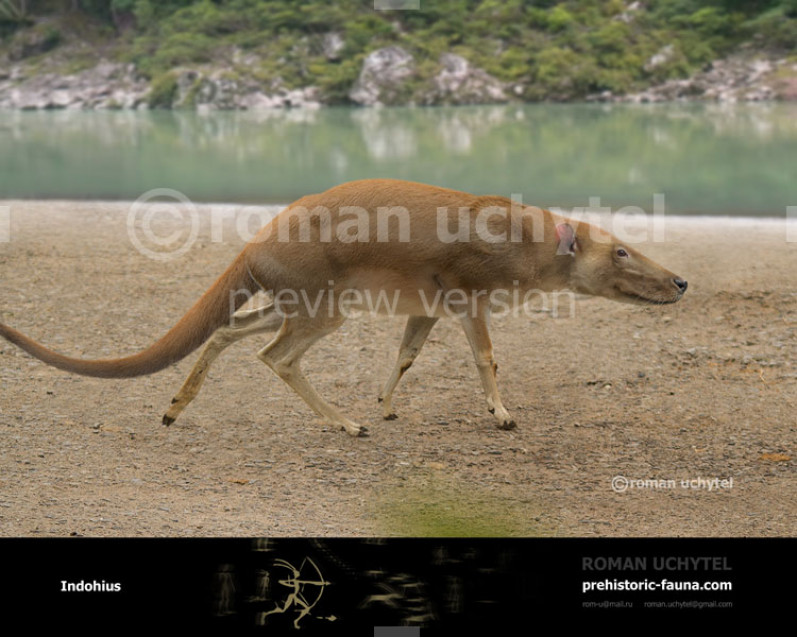
-797x638.jpg)
-797x638.jpg)


-70x56.jpg)
-70x56.jpg)

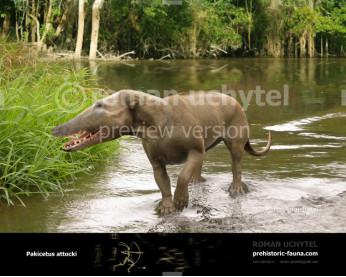
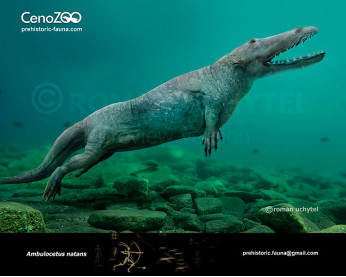
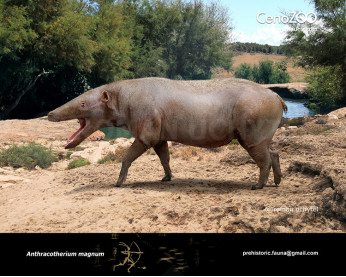
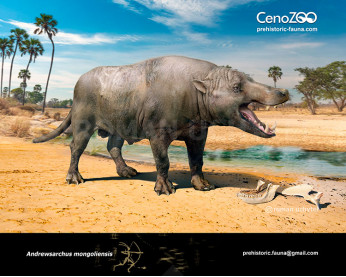
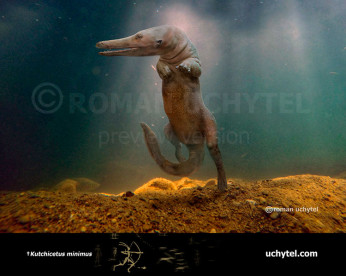
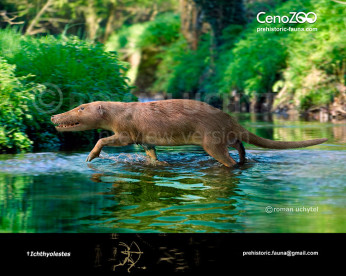
-346x277.jpg)
